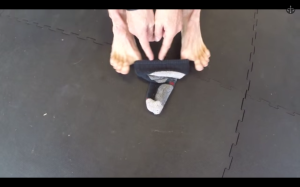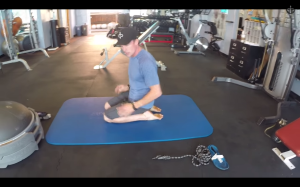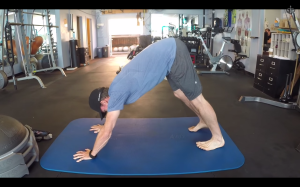Dear coaches,
I have a recurring problem with plantar fasciitis. I’m good now, but have flare ups every few months that have my foot hurting so much that I skip 2-3 weeks of training. What do you suggest I do when I have an injury like that?
Thanks!
One Foot For Now
Dear One Foot For Now,
Plantar fasciitis can be hard to kick and will have a tendency to come back if not taken care of properly. First of all, let’s describe what plantar fasciitis is: “plantar” is the bottom of your foot, and “fascia” is the connective tissue fibers between the skin and muscles. Lastly, “itis” means inflammation. So, unfortunately, plantar fasciitis is the inflammation of the connective tissue fibers of the bottom of the foot. But have no fear, OFFN — Here is a quick list of things you can do to heal (and even prevent) this injury from coming back:
#1. Sock Stretch

Sock Stretch
Do this at least three times a day for about 2-3 minutes. You can even do this stretch while doing something else, like reading a book or watching TV.
#2. Ankle Stretch

Plantar flexion
We will be stretching the ankle with two movements here. First, we’ll work on plantar flexion by sitting on our heels with our toes untucked. (This is actually harder than it sounds and it is OK if you can’t sit all the way down at first.) To make this stretch easier, you can roll up a small towel and place it under the front of your ankle while sitting down stretching.

dorsiflexion
The next stretch that you will do along with the plantar flexion is called dorsiflexion, which can easily be done by doing a downward facing dog stretch. While in down dog, you want to work on getting your heels down and make sure to press evenly between your hands and feet. Do this stretch twice a day, once in the morning and once at night.
Cycle back and forth between both stretches three times, holding each for about two minutes.
#3. Myofascial Release

Myofascial release
First thing’s first, you’ll want to grab a couple of different stretching tools, whether it be a trigger point roller, rubber hose, or even a PVC pipe. The point of myofascial release is to create a minor discomfort, or as my friend David Weck says, a delicious discomfort – I.E. not pain.
Next, we roll. This is done in a specific order, so pay close attention!
First, you will start by rolling the lateral (or outside) of the foot. Next, you will roll out the middle area. Finally, you’ll finish with the medial (or inside) of the foot. Roll from the ball of the foot to your heel.
You may want to start sitting down while rolling out and use your face as a good measuring tool. This means your face should be relaxed while rolling. If you’re grimacing because of the pain, you may be going too hard too fast. Remember to take it easy!
Spend around 3-4 minutes on each foot, two times a day. You can do this along with the ankle stretch in the morning and night.
#4. Nutrition
Sometimes, this problem can be solved with proper hydration and a magnesium supplement.
Getting the proper amount of H20 is ultimately going to give you a more fluid and flexible body, helping to heal and prevent further injuries. Make sure to drink adequate amounts of water for both your body type and activity level, and try to stay away from excess coffee, caffeine, and alcohol.
A magnesium supplement is going to help relax the muscles, aiding with restoring the body to a healthy state.
#5. Epsom Salt Bath
The oldest trick in the book, this is something you will definitely want to do during a flare up. A simple Epsom salt bath at night for 15-20 minutes will help ease away any aches and pains.
#6. Kinesiology Tape
Lastly, you can use kinesio-taping to help with the pain and healing of the fascia. This tape helps by increasing more blood flow and structural support to the area. Feel free to shoot me an email for any of your kinesio-tape needs.
I hope this helps, One Foot For Now! Just realize that it took a while for you to get into this situation, so it will take a little work to get back out there dancing, pain free. Follow these six steps and you’ll be on the road to recovery in no time.
-Coach Aaron
Have a question for the coaches? Shoot us an email!
